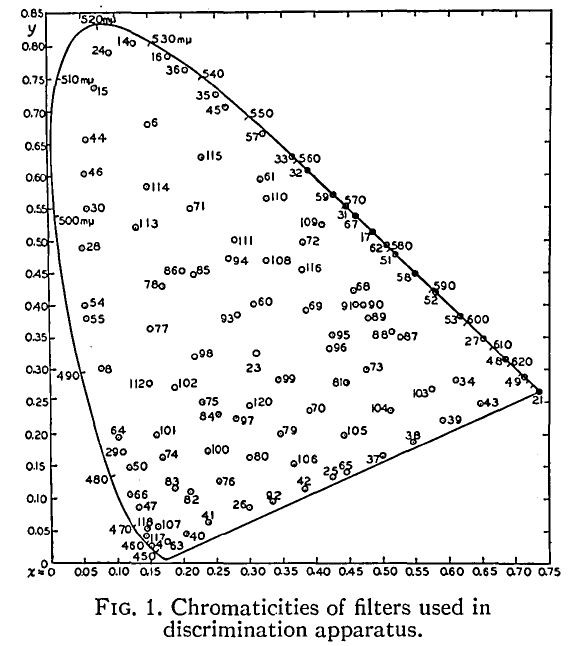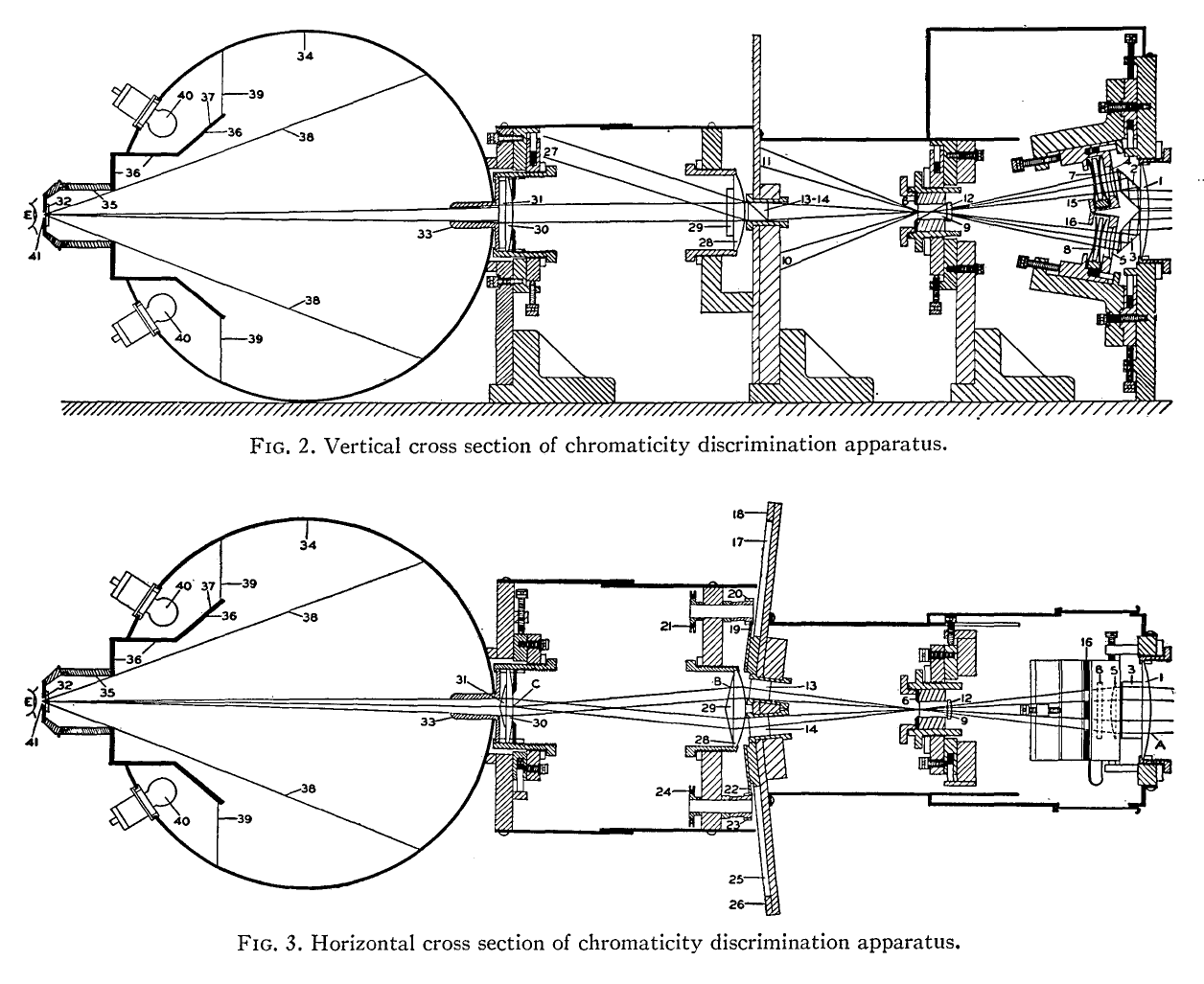David MacAdam undertook pioneering work in the field of colour difference perception in the 1940s. In particular, he designed the apparatus and refined the statistical process that enabled chromaticity tolerances round a target colour to be quantified.
MacAdam used Standard Deviation Colour Matching (SDCM) to define how closely (or not) the colour emitted by two light sources matched each other. As the standard deviation between any two samples increases the colour difference between them becomes apparent to more people.
Why is Standard Deviation Colour Matching important? For the lighting engineer a colour tolerance is expressed as a 1-step, 2-step, 3-step (etc) MacAdam ellipse.
No two light sources will ever emit exactly the same colour of light, but because multiple lights are generally installed next to each other a degree of consistency is very desirable. Therefore, lighting engineers need a way to express a tolerance around a target colour, in the same way that a mechanical engineer will express a tolerance round a dimension.
This article will explain the work of David MacAdam that gave rise to the now universal use of the MacAdam ellipse as means of expressing a tolerance round a target colour.
History. David MacAdam was a scientist working for Kodak in their research laboratory in Rochester, New York. In the 1940s Kodak was interested to find out how accurately the human eye could differentiate between similar colours.
Is colour matching easy? No, colour matching isn’t easy at all. We can perceive two different colours to be very similar, or we can perceive two similar colours to be very different because there are multiple factors involved in colour vision.
Before David MacAdam’s work was published, the lighting community had attempted to express the human ability to discriminate between similar colours in terms of wave length thresholds (for spectral, or saturated, colours like pure reds, greens and blues) and purity thresholds (for non-spectral colours like brown, pink and magenta).
Previous work, by other researchers, had tried to measure colour perception by looking for a “just noticeable difference”. This technique had the advantage that it was easy to implement and needed no very specialist equipment. However, it produced erratic results across the gamut of colours evaluated.
Other researchers (Wright and Pitt in “Hue discrimination in normal colour-vision”) had suggested that a better approach would be to make a large number of matches at each point in the colour chart and then to analyse the spread of the observations, but they commented that this would be “an impossibly lengthy process”.
David MacAdam’s research – a summary
MacAdam recognised that Wright and Pitt were correct in that multiple observations were required and that a statistical process was needed to analyse how close (or not) the attempted matches were to the target colours.
To overcome the difficulties that Wright and Pitt expected would create “an impossibly lengthy process” MacAdam designed and built an ingenious instrument to test the ability of an observer to match an adjustable test colour to a fixed reference (or target) colour simply by adjusting a single dial. Over the course of some 25,000 readings the ability of David MacAdam’s assistant, Mr Perley G. Nutting, Jr., was tested on 25 reference colours.
MacAdam started by choosing 25 points widely distributed across the CIE 1931 colour space diagram - see figure 48, below, from MacAdam’s original paper.

The centre point of each ellipse is a target colour selected by David MacAdam.
In his paper, MacAdam refers to the ICI 1931 standard chromaticity diagram. ICI is the International Commission on Illumination, more widely known today by its French acronym, CIE (Commission Internationale d’Eclairage).

MacAdam’s ellipses drawn on a coloured version of the CIE 1931 colour space diagram.
Each of these colour points could be produced by the use of a single filter, commercially available at that time. Some of the colour points MacAdam chose are more saturated (being close to the edge of the colour space diagram) than others which are closer to the middle. These colour points were to be the 25 target colours to which an observer would attempt to create a match.
Filters to replicate the target colours

The additional colour filters MacAdam created, plotted on the CIE 1931 colour space diagram.
Each target colour (above) could be replicated by combining light (in varying proportions) from up to 8 pairs of these additional filters.
MacAdam then created a series of about 100 additional colour filters. These were designed so that each of the target colours (above) could be replicated (in hue and purity) by mixing together (in whatever proportions were necessary) light from a pair of the additional filters. Generally, each target colour could be replicated by up 8 different pairs of additional filters if they were adjusted to the correct proportions.
MacAdam’s apparatus for generating the target and adjustable colours
The apparatus MacAdam designed is detailed below. In brief, it consists of a single light source (on the right) with colour filters (7 & 8), an arrangement of prisms and lenses (in the centre) and an eye piece (on the left).
From the single light source (far right) the apparatus produces two pairs of beams. One pair is polarised vertically, the other horizontally. Both pairs consist of a beam from filter 7 and a beam from filter 8.
The view presented to the observer at the eyepiece (far left) was as below.


The test field was in two parts: on one side was the target colour produced by one pair of beams in proportions that had been fixed in advance to match one of the target colours on the CIE 1931 colour space diagram with an illuminance of 48 cd/m²
On the other was an adjustable colour, also produced by a pair of beams from the same filters that the observer could adjust by rotating a single dial. The rotating dial was connected to a prism and as the prism was rotated the proportion of light from filters 7 & 8 changed accordingly. Whatever adjustment was made, the luminance remained at 48 cd/m².
Taking 25,000 readings
Before readings could commence a pair of filters was selected and the position of the prisms adjusted by calculation and observation so that the converging beams of light matched the target colour. Observations then began and it was the task of the observer (the patient Mr Nutting, who did this some 25,000 times) to adjust the dial so that the colour on the right of the test field matched the colour on the left (see diagram above).
When Nutting achieved what he considered to be a match the position of the dial (and hence of the prisms) was noted. According to the design of MacAdam’s apparatus, any change to the position of the prisms corresponded to a change of chromaticity.
Readings were repeated 50 times for each of the 5-8 pairs of filters that were capable of producing a colour match with the target.
For each set of 50 readings the results were recorded and the standard deviation was calculated and plotted on the CIE 1931 colour space diagram. For each of the 25 target colours the result was essentially the same, the standard deviation of all the attempted colour matches in each set fell in a pattern that described an ellipse centred on the target.

MacAdam’s ellipses, as presented in his original paper in 1942.
At the centre of each ellipse are the 25 reference colours to which he attempted to create a colour match. The standard deviation of the attempted matches from the reference colours is described by the ellipses, drawn here at 10x actual size.
Why are MacAdam’s ellipses important?
MacAdam’s ellipses are important because the techniques he used have given us the means of expressing a tolerance around a target colour.
In mechanical engineering it is said that a dimension without a tolerance is meaningless. In lighting the same is true. A colour match can never be perfect, so tolerances are essential.
When we describe a light fitting as having an SDCM<3 (for example), it means that, when new, the colour of the light emitted by any of those fittings will fall inside the boundary described by 3 standard deviations of colour matching from the central point, or target colour. To the great majority of people this level of variation is imperceptible. SDCM<5 is a looser standard and will exhibit higher levels of variability but is still perfectly acceptable for many applications.

What do MacAdam’s ellipses not do?
MacAdam was concerned to describe a method of defining tolerances. He was not concerned with quantifying the accuracy of colour perception across the human population as a whole. While his work did indicate that Nutting’s observations were not abnormal (they were replicated by a small number of other observers), MacAdam made no systematic study of the accuracy of colour perception between different sexes, ages or ethnicities.